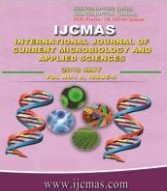


 National Academy of Agricultural Sciences (NAAS)
National Academy of Agricultural Sciences (NAAS)

|
PRINT ISSN : 2319-7692
Online ISSN : 2319-7706 Issues : 12 per year Publisher : Excellent Publishers Email : editorijcmas@gmail.com / submit@ijcmas.com Editor-in-chief: Dr.M.Prakash Index Copernicus ICV 2018: 95.39 NAAS RATING 2020: 5.38 |
Genome manipulation technology is one of emerging field which brings real revolution in genetic engineering and biotechnology. Genome editing technique is consistent for improving average yield to achieve the growing demands of world’s existing food famine. Because of their advantages such as simplicity, efficiency, high specificity and amenability to multiplexing, genome editing technologies are revolutionizing the way crop breeding is done and paving the way for next generation breeding. In different areas including plant research, new breeding techniques are of great concern such as plant pathogen resistance, developmental biology and abiotic stress tolerance. Meganucleases (MNs), zinc finger nucleases (ZFNs), transcription activator-like effector nucleases (TALENs) and clustered regularly interspaced short palindromic repeats (CRISPR)/CRISPR associated protein 9 (Cas9) are the four types of nucleases used in genome editing (Jaganathan et al., 2018). Homing endonuclease/meganuclease enzymes were the first among synthetic nucleases, to be used for genome editing purposes in plants, including Arabidopsis and maize. The recognition sites of homing endonucleases do not occur naturally in the plant genome, and this is the main limitation of these endonucleases as plant genome editing tools (Kumar & Jain, 2015). Chimeric restriction endonucleases were created as the first ZFNs and were shown to have in vitro activity. TALENs are similar to ZFNs and the DNA-binding domain is composed of highly conserved repeats derived from transcription activator-like effectors (TALEs), which are proteins secreted by Xanthomonas to alter transcription of genes in host plant cells. The type II CRISPR system is the most widely used from Streptococcus pyogenes (Amardeep et al., 2017). Protection is provided in bacteria, the type-II CRISPR system against DNA from invading viruses and plasmids via RNA-guided DNA cleavage by Cas proteins. Indeed, these emerging technologies have the ability to manipulate and study model organisms and these technologies promise to expand our ability to explore and alter any genome and constitute a new and promising paradigm to understand and treat disease (Gaj et al., 2013).
 |
 |
 |
 |
 |